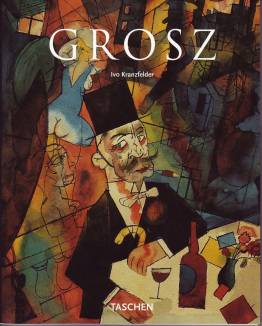|
|
|
Umschlagtext
www.taschen.com
Rezension
Dieser im Preis-Leistungs-Verhältnis überzeugende kleine Band bietet eine gelungene Text-Bild-Einführung in das Werk des George Grosz (geb. 1893 in Berlin als Georg Ehrenfried Groß, gest. 1959), deutsch-amerikanischer Maler, Grafiker und Karikaturist. Seine sozial- und gesellschaftskritischen Gemälde und Zeichnungen, z.T. drastische und provokative Darstellungen mit politischen Aussagen, entstanden überwiegend in den 1920er Jahren. Typische Themen sind die Großstadt, ihre Perversionen (Mord, Gewalt, Exzesse) sowie die Klassengegensätze, die sich in ihr zeigen. In seinen Werken, oft Karikaturen, verspottet er die herrschenden Kreise der Weimarer Republik, greift soziale Gegensätze auf und kritisiert insbesondere Wirtschaft, Politik, Militär und Klerus. Durch den 1. Weltkrieg wird Grosz polititsiert: Krieg war für ihn Grauen, Verstümmelung und Vernichtung, als strikter Kriegsgegner wie sein Freund John Heartfield, vormals Helmuth Herzfeld, wollte Grosz keinen deutschen Namen mehr tragen. Daher nannte er sich seit 1916 George Grosz. Er zeichnete viele Kriegsszenen, z.B. Soldaten ohne Nase. Seine Arbeiten haben bis heute großen Einfluss auf die politische Karikatur.
Oliver Neumann, lehrerbibliothek.de Verlagsinfo
George Grosz - The portrayer of types, as representatives of a social level or class George Grosz (1893-1959) was one of the most important exponents of Dadaism, and therefore of political painting in general. He not only condemned both militarism and bourgeois culture, but also set himself in opposition to traditional forms of art. The decisive element in Grosz's paintings is their content: in them he pointed out defects in the political and social conditions, literally arraigning them before the public. For Grosz, painting served as a political instrument: "I drew and painted from a sense of contradiction and through my work tried to convince the world that it was ugly, sick, and phoney." Grosz's paintings function as collages: the pictorial space is fragmented and thus takes on a futuristic aspect. Countless lines shoot through the pictures; the various visual planes collide with each other. Fascinated by the metropolis, Grosz depicted the wild and dissolute life in the bars and nightclubs of the Weimar Republic in the 1920s. He directed his attention to the shady side of life and filled his canvas with caricatures of distorted figures. Grosz never permitted human beings to emerge as individuals, but instead always portrayed types, as representatives of a social level or class. The Nazis castigated his works as "degenerate art". After the publication of his candidly drawn "pornographic illustrations", Grosz fell under strong criticism in the 1920s. Inhaltsverzeichnis
6»Allein mit meinen Doppelgängern«
8 Kolportagehefte und Gipsabgüsse 14 »Oh Emotion der großen Städte« 26 Revolution und Dada 40 Von Waffen und leeren Strohhalmen 52 Kritischer Realismus und Desillusion 76 Traum und Wirklichkeit 92 Georg Grosz 1893-1959: Leben und Werk 94 Bildlegenden 96 Anmerkungen |

 Bei Amazon kaufen
Bei Amazon kaufen